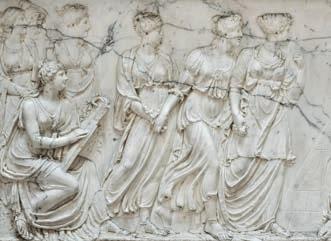
3 minute read
Alla luce del sole
Il Colle di San Giusto: un nucleo di monumenti che parlano di potere e volontà, culto e difesa militare e che simbolicamente definiscono l’identità di Trieste. — The hill of San Giusto: a stronghold of power and determination, worship and military defence, symbolising the very identity of Trieste.
CORRISPONDENZE D’ARTE ALLA LUCE DEL SOLE —In broad daylight
Advertisement
Il Colle di San Giusto risalta in piena evidenza su mappe e rotte; si potrebbe dire che è sempre alla luce del sole, eppure conserva un lato oscuro e complesso che gli conferisce un alone misterioso. È noto, infatti, che la stratificazione della storia tramandi ma anche confonda le tracce che lascia. L’Orto Lapidario e il Museo d’Antichità assieme alla Cattedrale e al Castello si trovano all’apice del colle, nel fulcro della città. Un nucleo di monumenti che parlano di potere e volontà, culto e difesa militare e che simbolicamente definiscono l’identità di Trieste. Se al museo fanno bella mostra di sé, ad esempio, le pregevoli collezioni egizie o tarantine, l’Orto, istituito in un’area un tempo destinata a cimitero cattolico, oltre a lapidi e a epigrafi, accoglie il Cenotafio dedicato a Johann Joachim Winckelmann, il celebre archeologo teorico del neoclassicismo. Egli morì accidentalmente e violentemente in una città particolarmente connotata proprio dai segni di quanto lui stesso aveva teorizzato: la nobile semplicità e la quieta grandezza, che sono i presupposti della vera bellezza che accompagna lo stile classico.
Accanto al Cenotafio che si trova all’interno del tempietto, sono esposte molto opportunamente le statue appartenenti agli Arcadi Sonziaci che diventano quasi emanazioni del suo pensiero e numi tutelari.
Statue greche, antiche e assai preziose, il nucleo primigenio dei musei triestini della città moderna, giunte per volontà ma anche per buona dose di casualità in una città portuale
ed internazionale, che nell’Ottocento, reperto dopo reperto, opera dopo opera, tra acquisti e donazioni andava costruendo la sua identità. Ecco quali sono i molteplici frammenti da cui partire per vivere un luogo ombreggiato ma ricco di dettagli luminosi: ombre e luci come il suo indecifrabile carattere.

ENGLISH TEXT
The hill of San Giusto is clearly visible on maps and routes it would appear to hold no secret, always in plain view, overshadowing the rest of the city. Yet, it has shadows of its own, a dark side, the complexity of which lends an aura of mystery to this area. The numerous layers of history, after all, often hide ambiguous details within their folds. The top of the Colle is crowned by some of Trieste’s most important monuments, such as the Orto Lapidario (i.e. lapidary garden), the Museo d’Antichità (i.e. antiquities museum), the Castle, and the Cathedral: a stronghold of power and determination, worship and military defence, symbolising the very identity of Trieste. The museum’s display includes invaluable collections of Ancient Egyptian and Taranto (Southern Italy) finds, providing an ideal link with the lapidary garden, where alongside headstones and epigraphs from the former burial ground the Cenotaph commemorating famous archaeologist and Neoclassical art historian Johann Joachim Winckelmann is located. Winckelmann was murdered in Trieste, the very embodiment of his intellectual doctrine: the ideal of “noble simplicity and quiet grandeur” (edle Einfalt und stille Größe), prerequisites of the real beauty according to the canons of ancient Greece and Rome.
The tempietto (i.e. small shrine) hosting Winckelmann’s Cenotaph is guarded by the opportunely placed statues that used to belong to the collection of the Accademia degli Arcadi Sonziaci (a group of 18th-century intellectuals funded in the area of the Isonzo river, N/T) almost tutelary deities and physical emanations of Winckelmann’s doctrine.
This prize set of ancient Greek statues is the corner stone, upon which the first museum centre of modern Trieste was built. It contributed to the development of the city’s identity, find after find, artwork after artwork, as an increasing number of pieces and donations were brought or found their way almost haphazardly to this international maritime hub. These fragments are the first steps on the path to discover this hill of shadows and light and its obscure, yet luminous soul.










